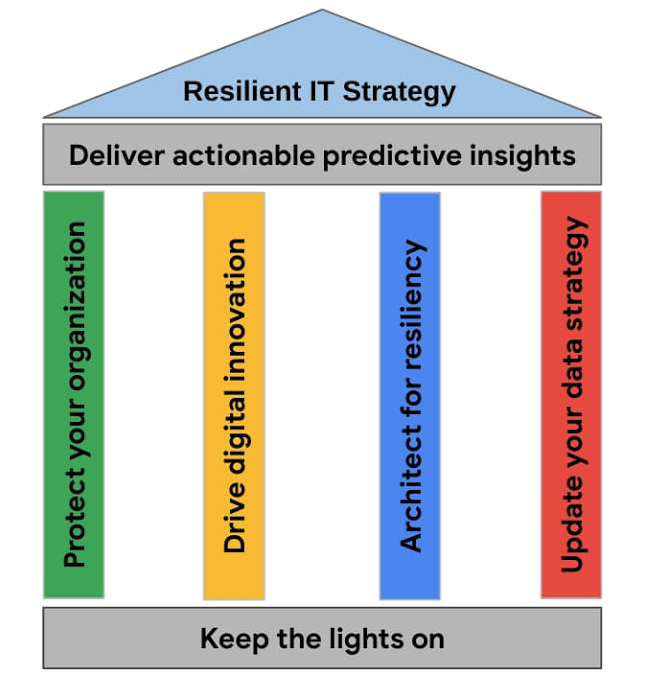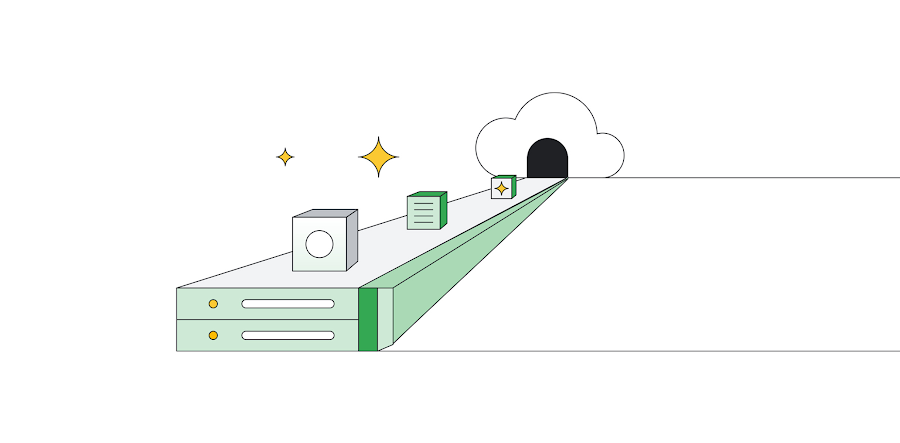Rethinking business resilience with Google Cloud
Moreno Nolo
Enterprise Cloud Architect, Google Cloud
During my last 20 years of IT projects and consultancy across enterprise businesses, I have seen recurring patterns being implemented to deliver a resilient IT strategy. Challenges across security, operation, innovation, data strategy, and insights are very common for enterprises looking to modernize. 2020 has so far proven to be a very challenging year for everyone, and enterprises want to plan, architect, and build resilient strategies to keep their business successful. My job as an Enterprise Cloud Architect at Google Cloud is to help enterprises on this journey, and I have collected different critical success factors to navigate such challenging times. In this article, I share my experience, those critical success factors, and the methodology I developed to achieve a resilient IT Strategy through Google Cloud.
What is Resilient IT Strategy (RIS)
Achieving business resilience, one of the main asks from management boards, is keeping your business successful both during these difficult times, and also in the future. This means protecting employees, maintaining the core business running, and accelerating your digital transformation.
I’ve grouped the success factors (or pillars) needed to achieve business resilience in the following methodology that I call RIS: Resilient IT Strategy.


The “house of resiliency” is helping reimagine a business model to achieve business resilience. The foundation is led out at the bottom of the house with “keep the lights on,” the first of the six pillars from the RIS-Model. The vertical pillars revolve around best practices on security, innovation, resiliency, and data strategy. The last pillar shown on top is “deliver actionable data insights.” Let’s go through each of the pillars and see how this can help solve these challenges with Google Cloud.
1. Keep the lights on
IT is not only a business enabler but also a business driver, and IT operations truly is the “engine” of your business. This is why “keeping the lights on” with IT operations is such an important foundation to our house of resiliency: without that, your business engine stops. In this section, I would like to share how enterprises can achieve that goal when using Google Cloud.
The first step to take is to follow our best practices for enterprise organization. This article helps enterprise architects and technology stakeholders plan a solid foundation across identity and access management, networking, security, cloud architecture, billing, and management. To expand on the foundation, our Solving for Operational Efficiency with Google Cloud whitepaper is full of insights on how to optimize IT Operations. It also highlights how to optimize costs, and plan for a more agile and scalable future.
2. Protect your organization
Legacy enterprises that are used to monolithic applications and are starting their cloud journey are often challenged by different aspects of security in the cloud: application security, secure access to internal apps, or security analytics. Protecting the organization, and detecting and stopping threats are always a priority. In this pillar, I would like to share a few modern approaches that can make a difference. We, at Google Cloud, believe that they can significantly help make it easier to defend your business. Let's go over three areas where cloud technologies can be transformative:
1. Security analytics and operations
Analytics and operations is a security topic that presents significant challenges, as many enterprises don’t have the ability to store and analyze large amounts of security telemetry. The goal is to reduce the cost to analyze and store this data and increase the speed of gaining insight from this data. Cost is often a reason why enterprises limit the retention of their security telemetry data, reducing their capabilities to analyse and detect threats. Our solution based on Chronicle and VirusTotal offers painless scalability combined with intelligent identification. The result of that is that you can analyze many risks at the speed of Google search while reducing cost. Read this Chronicle customer case study of a global healthcare company to learn more.
2. Application Security
Protecting users and applications requires constantly updated knowledge to new security threats. Our Application Security solution, which includes reCAPTCHA Enterprise and our WebRisk product, relies on Google’s years of experience in defending our own services. This means you can better protect your apps from fraud and abuse with an enterprise solution that can easily integrate into site or mobile apps, in the cloud or on-premises.
3. BeyondCorp Remote Access
VPNs were not intended to be used for always-on remote access, and in these times where remote work is the norm, they can be a significant productivity sink for end users and IT admins. BeyondCorp Remote Access delivers simple and secure access to internal apps for your employees and extended workforce without the use of a VPN. Learn more about BeyondCorp, the Zero-Trust security model, and how Airbnb implemented it using Google Cloud in this video.
3. Drive digital innovation
Innovation has always been a key driver to accelerate growth and prevent future disruptions. Driving digital innovation is the third pillar of our RIS-Model. Unfortunately, innovation is often done in iterative cycles, without taking into account the entire IT strategy. I believe that innovation is a holistic topic that must be driven consciously by the top of the enterprise, and by the architecture teams. The goal is to let the business units drive the innovation on behalf of their customers. That’s why digital innovation at Google is part of our DNA. You can find out how Google Cloud helps you solve for innovation here.
This third pillar lets you build business capabilities and services to remain relevant in future. Google Cloud is tackling these challenges by focusing on reimagining how to manage apps and infrastructure with an agile and open architecture. We have introduced a new Google Cloud Application Modernization Program (CAMP) during our recent Next conference. It is based on our experience of driving application delivery at speed and scale, and relies on the principles developed by the DevOps Research and Assessment (DORA) team which is based on six years of research and data from over 31,000 professionals. Read more about CAMP and how to get to the future faster.
4. Architect for resiliency
The fourth pillar of the RIS model is designing IT architectures that are flexible, resilient, and scalable. In other words, part of this mission means building flexibility into your architecture, staying agile, and adopting an open cloud architecture in order to respond to change. Furthermore, architect for scalable and resilient solutions across your organization to build resilient systems. Scalability to adjust capacity to meet demand and resiliency to design to withstand failures. These are two essential goals within this pillar. Google Cloud has introduced some patterns and practices for scalable and resilient apps that helps you architect with these principles.
In addition, Google has built the Site Reliability Engineering (SRE) methodology through years of running global apps serving billions of users. You can see SRE as an implementation of the DevOps principles in your organization. Culture has always been a key part of the DevOps, Agile, and Lean movements, driving both software delivery performance and organizational performance. We found that SRE principles like “Accept Failure as Normal,” “Reduce Organisational Silos,” “Implement Gradual Change,” “Leverage Tooling & Automation,” and “Measure Everything” are providing a common theme to work across organizations. These principles also support a culture and way to work. Read more on how to start and assess your journey for SRE.
5. Update your data strategy
A clear data management strategy to generate business value is a critical success factor for any business. Enterprise businesses today often struggle to achieve this goal because CRM, ERP, consumer and customer data are often residing in data silos. That’s why the fifth pillar of our RIS-Model is about your data strategy and how you can update and build your data strategy for the modern era. Each customer’s journey is different and, with that, so is the data strategy that you define.
Enterprise leaders are keen to find new ways to use data to improve customer experiences, find new business opportunities, and generate unmatched value and competitive advantage. They are looking for opportunities to embrace technologies like open source and multi-cloud to avoid vendor lock-in. Google Cloud introduced Anthos, a new platform for managing applications in today’s multi-cloud world. However, if executed poorly, a multi-cloud strategy increases the data silos problem. For this reason, you should strive for a consistent data experience across clouds. A modern multi-cloud data strategy is needed to let you extract value from data, regardless of type, size, and independently of where your data is stored. This ability brings the power of analytics to where your data lives, in different public clouds (Google Cloud, Amazon Web Services, and Azure) and provides a single-pane-of-glass for your data. In a multi-cloud world, businesses need to break down data silos without moving data between providers and gain critical business insights seamlessly across clouds. Google Cloud has recently introduced BigQuery Omni to help you build this pillar: it lets you query your data in Google Cloud, AWS and Azure (coming soon).
Here’s a step-by-step guide which provides you insights on how to update your data strategy. The report shares different aspects on how to expand your data strategy, along with customer case studies that complement this pillar.
6. Deliver actionable predictive insights
Unlocking data’s value is every company’s crucial and challenging mission that is covered in the sixth pillar of the RIS-Model. Leveraging data, becoming data-driven, and empowering predictive analytics; these are the goals of many enterprise businesses. The previous pillars should have highlighted the main required steps to build a good framework to really benefit from all the value that lives inside your data. This pillar is about gaining insights from your business, partners and customers. By using Artificial intelligence (AI) and machine learning on Google Cloud, you can implement many different use cases to solve your business pain points and deliver business value to your customers. With that you can gain real-time insights that improve decision-making and accelerate innovation, in order to reimagine your business. For example, learn how the State of Illinois is using AI to help residents who lost their job because of COVID-19 file hundreds of thousands of unemployment claims.
To summarize, the methodology helps you navigate these difficult times by focusing your work on a resilient IT Strategy through Google Cloud. The six pillars represent disciplines that you need to build, maintain, and evolve to transform your business across the key success factors in order to keep it successful. Ultimately the approach is a guideline for business and IT stakeholders, which should return stability, value, and growth on your journey with Google Cloud.
Thank you to Théo Chamley, Solutions Architect at Google Cloud, for his help on this article.




